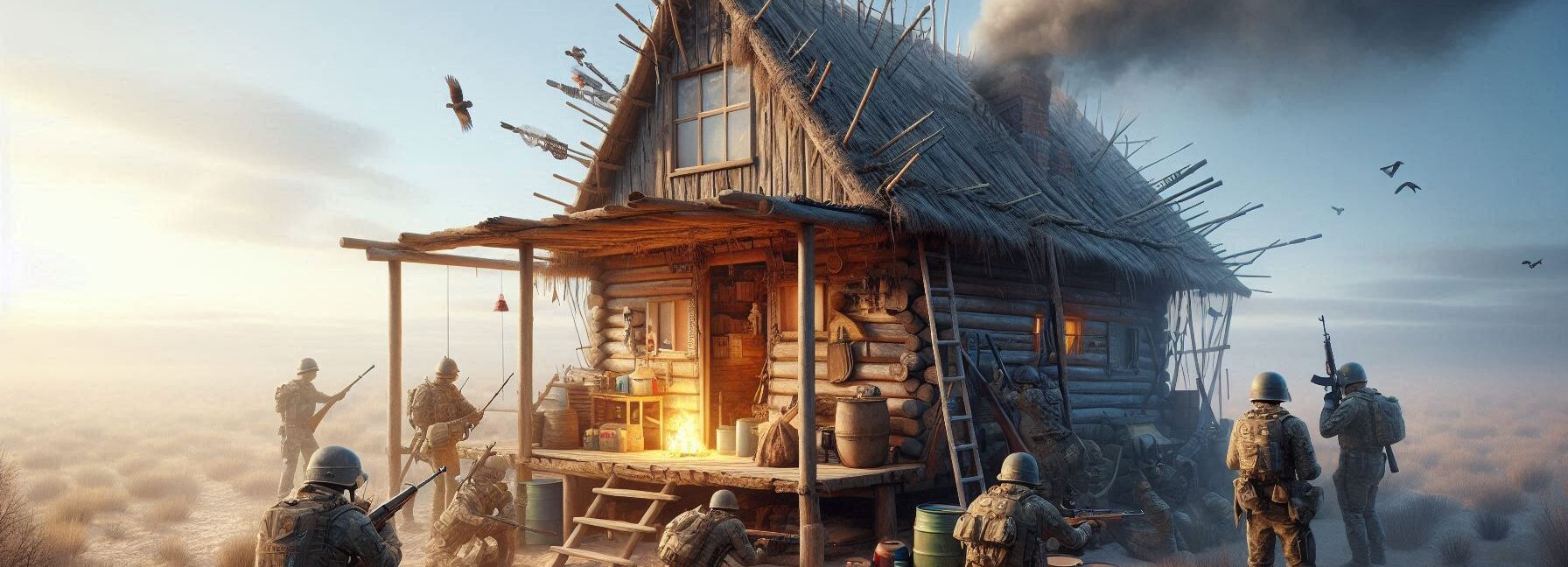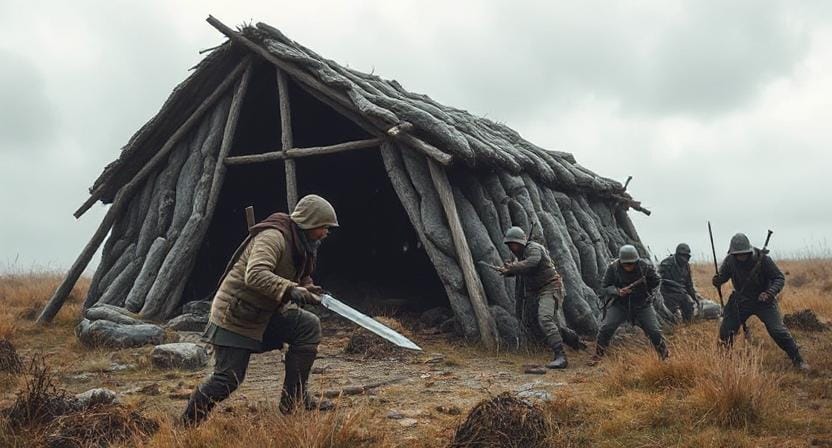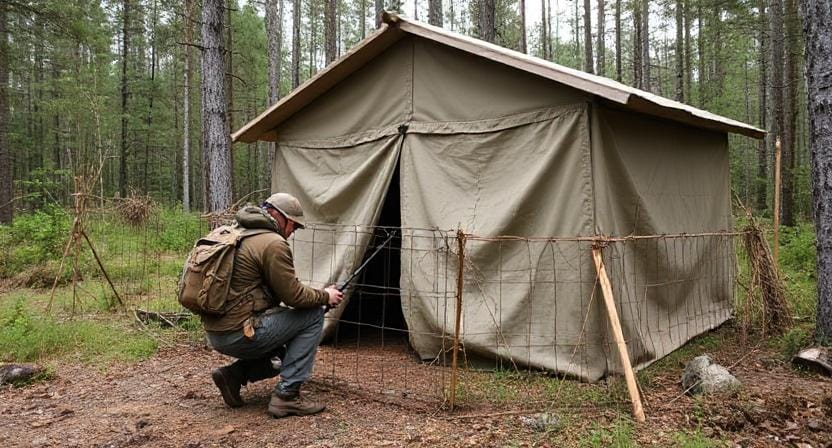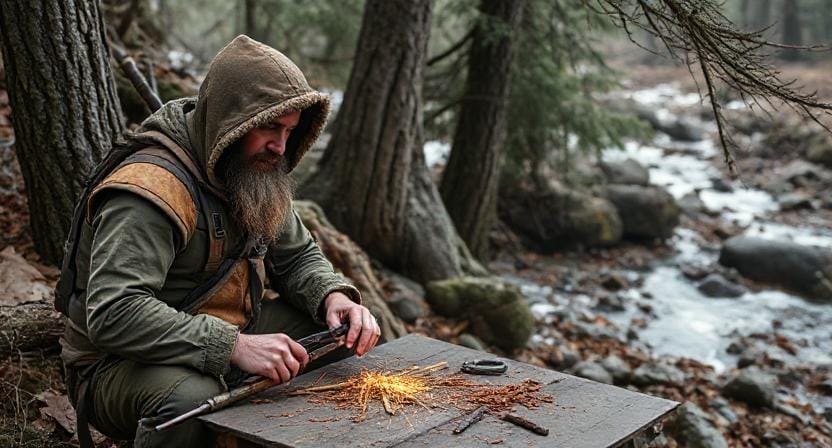Please Note: This post may contain affiliate links. If you click one of them, we may receive a commission at no extra cost to you. As an Amazon Associate, I earn from qualifying purchases.
Last Updated on November 2, 2025 by Kevin Collier

Top Takeaways and Key Concepts
- Assess terrain; use natural obstacles and high ground to minimize exposure.
- Reinforce entrypoints with strong doors and heavy-duty locks.
- Camouflage shelter and decoy trails to avoid detection.
- Install noise deterrents—tripwires, cans, or motion-activated alarms—near approaches.
- Forge alliances with neighbors and establish mutual watches and escape routes.
So, you've made your fantastic shelter for the end of the world. Yay for you! Everyone gets a high five. But hold for a second—before you pop the beans and scatter confetti, we need to talk about how to keep your home safe.
Imagine this: you're sitting by the fire, drinking tea. Doesn't it sound good? But suddenly, boom! A squad of raiders comes to get your valuable stash of canned peaches. What a mood killer!
First, think about the entry of your shelter. A strong door, maybe one that's hard to break down, may make a major difference. It's also very crucial to have small items like a lock. You want to know whether someone is trying to get in.
Next, lighting can be your secret weapon. Putting up some lights around your house can assist. It might scare off those annoying raiders. At least they'll think twice before doing something stupid.
Next, think about the sound. You want to know when someone is sneaking up on you, right? You might want to acquire some old-fashioned wind chimes or a simple bell to let you know when things are getting out of hand.
Let's talk about your hoard now. Put your wonderful food in a place where it isn't simple to find. You could hide it, or even better, make it look like you don't have much at all. A little deception can go a long way!
It's always smart to have a backup plan. Just in case, think about ways to get away. It's good to have a route out that keeps you safe if things get too crazy.
It doesn't have to be all doom and gloom to keep your shelter safe. Your snug shelter can become a fortress with a little inventiveness and a lot of common sense. You worked so hard to make this place. Let's keep it safe so you can enjoy those quiet nights with just you and your can of beans. You can do this!
Contents of This Page
*** Shop for Survival Gear - Tools - Kits ***
Survival Gear - Bags and Backpacks - Knives - Boots/Footwear - Communication
Outdoor Cooking - Gloves - Hydration - Dry Boxes - Water Filtration Systems
Tents - Sleeping Bags - First Aid Kits - Multi-Tools - Flashlights - Fire Starters
Navigation - Survival Food - Night Vision - Headlamps - Stun Guns - Binoculars
Assessing Your Surroundings: The First Line of Defense

First, look around you carefully. You wouldn't want to put your stronghold next to an old amusement park where zombies may walk around freely or in a valley that is effectively a highway for raiders. They don't care about your personal space or limits, believe me.
Find natural obstacles, like rivers or high hills, that can keep intruders out. Think of yourself as a player in a game of hide and seek where you have to outsmart both nature and possible attackers.
If you're on flat land with no cover, think about putting up some strategic barriers around your shelter. Think of logs, boulders, or even stacks of old tires (because who doesn't like to recycle?).
If you have trees around, make friends with them! Climbing up into the branches can give you a good view of problems before it gets there, like Tarzan but without the loincloth.
Building Strong Barriers: Fortify Like a Pro

It's time to strengthen your shelter now that you've looked about. It's not enough to merely slap some wood together and say it's “good enough.” No way! We need walls that can handle anything short of a full-blown tank attack. And even then, good luck.
Begin with strong materials, like large logs or metal sheets that have been reinforced. You don't want walls that are so weak that they would give way under the weight of an enraged raccoon, let alone a human threat.
And while we're on the subject of raccoons, make sure all the doors are locked! A door made of recycled cardboard won't keep anyone out, not even the most bewildered squirrel. Use heavy-duty locks or, even better, barrels full of pebbles that are placed near entry points and will tumble down when someone tries to sneak in (just kidding… sort of).
Camouflage: Outsmart Your Would-Be Invaders

Let's get creative now: camouflage! You're not just trying to get away from raiders; you're also trying to blend in with your surroundings like a ninja who wants to survive. The plan is simple: make your refuge look less interesting than the loot that invaders think they can find somewhere else.
You might want to think about covering the outside of your shelter with natural materials like leaves and branches. I did this once while camping, and I ended up looking more like Bigfoot than a real building!
But it worked! Just remember that if it looks and smells like nature (preferably without any skunks), it's very likely that unwelcome guests will go.
Adding things like phony animal trails that lead away from your shelter could make potential enemies think there's something more fascinating down the road. This is a creative trick that would be great for any espionage movie!
Making Noise Deterrents: Making Noise to Scare Off Intruders

Everyone hates noise when they're trying to relax or sneak around silently. That's why noise deterrents are so useful for keeping your place safe.
Put tripwires on cans full of rocks near doors (or anywhere else that seems right). What happens when someone steps on those wires? BAM! Alarm system right away! It's impossible not to giggle when you picture raiders springing back in shock when their sneaky plan goes wrong because of the noise of pots and pans.
If you want to spend a little more money, you could also get motion-activated alarms. They make loud noises that will scare off anyone who thinks breaking into your home is a good idea.
Teamwork Makes the Dream Work: Making Alliances

Lastly, and maybe most crucially, you should never do it alone when fighting off threats unless you're quite comfortable being a lone wolf (and even then…).
Allies can assist make defenses stronger because, let's face it, two minds are better than one, especially when one head knows a lot about how to stop invasions!
Make friends with your neighbors or other survivors nearby so that everyone can share ideas about how to stay safe and share resources. This is also the old “I'll watch your back if you watch mine” technique.
Plus, having pals means you'll have somebody around to tell you stories about your past exploits on those long evenings, even if half of them are about humiliating things that happened with raccoons!
Conclusion
It's like putting together a puzzle to protect your shelter after the end of the world. You should plan ahead and be a little inventive. Let's take a look at it piece by piece.
First, it's important to check around your home. What's close by? Are there places where someone could sneak up on you? A brief look can help you find those hard-to-see spots.
Now, think about how you want to set things up. Is it powerful enough? You might want to give it some more help. If you have them, you may use wooden beams or even sandbags. It's like giving your home a big, warm embrace to make sure it feels safe and cozy.
Then, think about working with other people. It can be really helpful to have pals close by. They can also keep an eye out and offer ideas. Also, it's good to have someone around when things get hard. You know, maintaining watch while exchanging snacks and stories.
You have to get supplies. Get some extra food and water. Cans of beans, dried fruits, and other things that endure a long time. And don't forget to bring first aid kits! You never know when a minor cut could need some attention.
And we shouldn't forget about those surprise guests. They may want freebies, but we'll be ready for them. With only your brains and the will to keep what is yours. A small plan can make a big difference. Believe me, it's nice to know you're ready for anything.
There could be surprises tomorrow. Maybe another party wants to find your secret treats. That's fine, though. You'll be ready with some thought and planning. So get those things today. Put love into that shelter and get ready for what's next.
Frequently Asked Questions
How does terrain choice help protect a shelter?
Higher ground and natural barriers reduce blind spots and make approaches harder for raiders to exploit.
Why reinforce doors and entry points?
Stronger doors, frames, and locks increase time resistance and make forced entry significantly more difficult.
How does camouflage reduce risk of detection?
Blending structures into the environment makes shelters less noticeable and discourages targeted attacks.
What noise-based deterrents help warn of intruders?
Tripwires, cans, bells, or motion alarms alert you early so you can respond before intruders reach key access points.
Why should resources and food be hidden?
Disguising valuable supplies reduces temptation and lowers the likelihood that raiders will attempt a direct breach.
How do alliances improve shelter security?
Neighbors can share watch cycles, coordinate responses, and act as force multipliers during emergencies.
Why is having an escape route important?
Backup exits provide safe fallback options if primary defenses fail or shelter integrity becomes compromised.
Suggested Resources:
Survival Skills You Need Before SHTF
https://www.survivalskills.com/shtf-skills
How To Build a Survival Shelter
https://www.outdoorlife.com/how-to-build-survival-shelter/
Self-Defense Techniques for Preppers
https://www.prepperwebsite.com/self-defense-techniques-preppers/

Kevin Collier is a seasoned survivalist and expert in prepping and homesteading, contributing to WiseSurvive.com. With a deep-rooted passion for self-sufficiency and outdoor survival skills, Kevin shares practical advice, strategies, and resources to help individuals prepare for any challenge. His informative articles cover a range of topics, from essential survival techniques to sustainable living practices, empowering readers to thrive in any situation. Whether you're a novice or a seasoned prepper, Kevin's insights will inspire you to take charge of your readiness and build resilience for the future.




